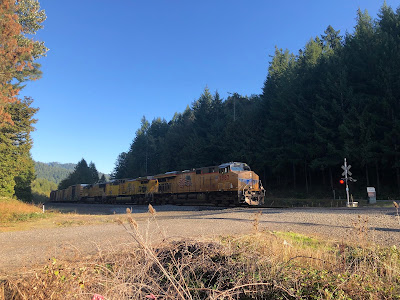Once again, I have been away from the model railroad for a bit this fall. It is not the easiest reality to deal with. For sure there are worse scenarios, but as a firm believer in the ever-popular "hour a day" approach, the modeling withdrawals are significant and weathering projects can only do so much to ease the pain.
However, there is a silver-lining. My academic pursuits have brought me to Eugene, OR, which, besides being quite a quirky town to live in, also is the base of operations for Union Pacific's Cascade Subdivision. (Technically speaking, Eugene is part of the Brooklyn Sub, but for the sake of Cascade Sub discussion, I happily throw Eugene into the pile.) That being said, I now have unique access to the rail line that I model and a daily supply of inspiration and motivation.
In seeing the railroad I model every day I have noticed and become familiar with nuances that I otherwise would not have encountered through photographs or short railfanning trips alone. For example, sometime in mid-late October, the "snow-fighters," retro-fitted GP38-2's arrived in Eugene and were moved to Oakridge for service in early November. Additionally, I have kept note of what locomotives are pulling road freights and which locomotives are in helper service. These details are helping to form a more realistic locomotive fleet and operating scheme that captures the essence of the line.
Furthermore, extended time in a place allows for longer, "slow" observation. This reminds me of a practice once described by an art student of observing a piece of art for hours on end to soak in all its detail. This practice has helped me soak in the character of the Cascade Sub and has started to form a better understanding of the essential elements, those most relevant to create the proper look and feel. Not every bush, tree, track, and industry can be modeled, and so in studying how these elements interact with each other over an extended period of time, I hope to be able to better capture (or draw up a plan of attack on how to capture) the prototype in model form. High-level modeling theory, but there is not other way to describe it! Modeling is an art form.
So what does this mean for my modeling efforts now and in the future?
1. Fleet Building - As I continue the process of growing my fleet of locomotives and cars, my approach has become much more focused and specific. In considering what locomotives and cars to obtain for the railroad I ask myself if it is seen regularly, how is it used in the general operating scheme, and does it add realism and value to the railroad. Additionally, I have become much more motivated to appropriately weather every piece of rolling stock and each locomotive. I have come to realize I am in desperate need of 60' boxcars, woodchip gondolas, centerbeam flatcars, and AC4400's (looking forward to Athearn's foreshadowed release).
2. Modeling Generally - With more time to experience the area, I have acquired a better appreciation of structures, infrastructure (roads, bridges, trails), and natural elements that I want to model and how to model them. "Being around" has given me time to take a look at things from different angles and at different times of the year. For example, I try to swing through Oakridge a few times a month. This routine has instilled in my mind certain elements that scream OAKRIDGE! and accordingly, are elements that if were missing from a model of the yard would make that model less authentic. Time and building "research" into my routine has helped me grow familiar with the character of the area and accordingly a better understanding of how to capture that character in modeled form.
3. Operations - This one might be self-evident, but I have had the opportunity to observe the day to day operations of the railroad. I won't go into too much detail on this element because I think it is clear how this translates to the model railroad, namely developing an operating scheme that represents the prototype faithfully.
4. Cascade Sub 2.0 - Finally, I have started drafting plans for the next version of the Cascade Sub. Admittedly this is a very exciting prospect and I have to keep my desires to start anew in check for now. That being said, the Cascade Sub 2.0 will hopefully incorporate as much of Eugene yard and Springfield as possible to add some switching and classification to the operating scheme. Also, I would like to incorporate some interchange with local short lines. My plan is to build the next version of the railroad using the TOMA approach so that the layout is only semi-permanent and various modules can be relocated when necessary. I have already drafted plans for the first few modules. That, of course, is for another day, but it doesn't hurt to dream!
So if you ever find yourself away from your model railroad for an extended period of time or are looking for a prototype to model, just look around in your own neck of the woods. There is value in recreating what is experienced daily and modeling what is ordinary. In my short time in Eugene, my routine of observation has allowed me to connect with the place around me in a meaningful way. When I can't head down to the basement and bring my own Cascade Sub to life, I can hop in the truck with camera and notepad in hand and head to the tracks knowing the real thing will do just fine, and is ultimately still the railroad I love.





